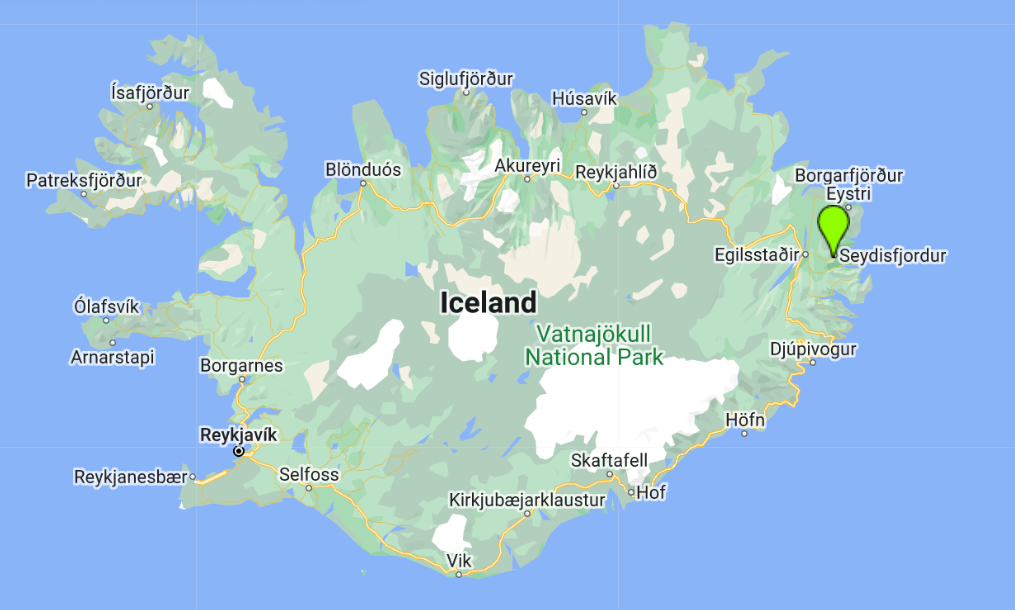A drive to Seyðisfjörður
The view that Seyðisfjörður is famous for with its blue church and rainbow path
Seyðisfjörður is an incredibly pretty little town in East Iceland, located at the furthest inland point of a fjord of the same name. It is surrounded by incredible nature, including mountains, waterfalls and beautiful sea views, but is quite small, only having around 670 inhabitants. There is a nature reserve nearby, called Skalanes, which covers over 1200 hectares and is known for its diverse wildlife, boasting 47 species of birds, four species of Icelandic mammal and over 150 species of plant life. There are reindeer here, along with seals and porpoises on the shores, and apparently over 90 archaeological sites, many dating back to the war. Seyðisfjörður was a base for Allied forces during the Second World War. The one attack recorded off Iceland occurred on the British oil tanker, the El Grillo (“The Cricket”), which was anchored in the fjord at the time. After heavy bombarding by German fighters who were stationed in Norway, the El Grillo’s captain decided to scuttle the ship. The El Grillo was sunk without loss of life and now rests at the bottom of the fjord, where it is a popular site for scuba divers.
The settlement of Seyðisfjörður began to develop the 1800s, due to the fishing of herring – known at the time as “the silver of the sea”. Due to the sheltered and protective nature of the long fjord, the fisherman in Seyðisfjörður had an advantage over their neighbours, leading it to grow into one of the most prosperous towns in East Iceland. The town became a base for Norwgian merchants and whalers who built many of the multi-coloured wooden buildings that make Seyðisfjörður so unique and recognisable were built in this period by Norwegian merchants and whalers.
Seyðisfjörður on the edge of the fjord and nestled into the mountainside
The steep-sided valleys around Seyðisfjörður make the town prone to avalanches. An avalanche in 1885 killed 24 people, making it the worst avalanche tragedy in the country’s history. There is a memorial for the dead which stands in the town, constructed from the beams of a destroyed factory. More recently, in 1996, an avalanche crushed another local factory. Luckily, no one was injured. Avalanche dams, some as high as 20m, have since been constructed around the town.
Seyðisfjörður is only thirty minutes or so from the ring road route 1, but it gets no passing traffic, as the road to it from route 1 ends at the town, so you are only going to go there if Seyðisfjörður itself is your planned destination. However, it is well worth the trip as it is definitely one of the most picturesque towns in Iceland with breathtaking scenery surrounding it – in fact, the whole of the drive there from Egilsstaðir is absolutely beautiful, as you have to drive over the mountain pass that lies between Egilsstaðir and Seyðisfjörður which is stunning in itself and which also features several gorgeous waterfalls, making this a very scenic drive.
Gufufoss waterfall
One of the best things about the drive was passing the majestic Gufufoss waterfall which is in the Fjarðará river and is the biggest waterfall that flows into Seyðisfjörður. We decided to stop and take some photos of it before continuing down into Seyðisfjörður town itself. The word gufa in Icelandic means vapour or steam so Gufufoss translates as the steam falls, which is quite appropriate as the spray that comes off it forms a mist that looks like steam coming up from the waterfall itself. There are a couple of hiking trails along the river Fjarðará but we were pushed for time, so contented ourselves with parking in a layby near the waterfall and walking to it to take some pictures. Given its remoteness, it doesn’t attract crowds in the way that other famous waterfalls in Iceland do, which made it even nicer to stop and visit. Even though we didn’t have great weather, the views were lovely.
The falls thundering into the Fjarðará river
Arriving at Seyðisfjörður itself, the town also feels very remote, which adds to its charm. This quirky little fishing village feels a bit like a hidden gem, although to be honest these days it is very much on the tourist trail. In the summer season the town can get very busy indeed as locals and tourists come to enjoy the nature, the vibrant cultural scene and the quaintness of the town itself, and of course to take a photo of Seyðisfjörður’s iconic blue church with its rainbow pavement next to it. One of the prettiest churches in Iceland, Seyðisfjarðarkirkja features in many guide books and is frequently painted and photographed. Of course, despite the low cloud and sea mist we too had to photograph it and get the famous blue church/rainbow street shot.
Seyðisfjarðarkirkja
We discovered that there was a rather nice café on the rainbow street so stopped to have a bite to eat after taking a walk around the town. Being a Sunday, there was very little open so we didn’t do a great deal while we were there, but spending a peaceful couple of hours in Seyðisfjörður was well worth it, even though we didn’t do a great deal there. It was a little oasis of calm in an otherwise busy holiday.
Looking up the fjord flanked on both sides by the pretty little town
There are many lovely hiking trails in the stunning scenery around Seyðisfjörður and I would love to come back and stay here for a night or two, and do a bit of walking – and also visit the nature reserve. Definitely worth revisiting one day soon.










